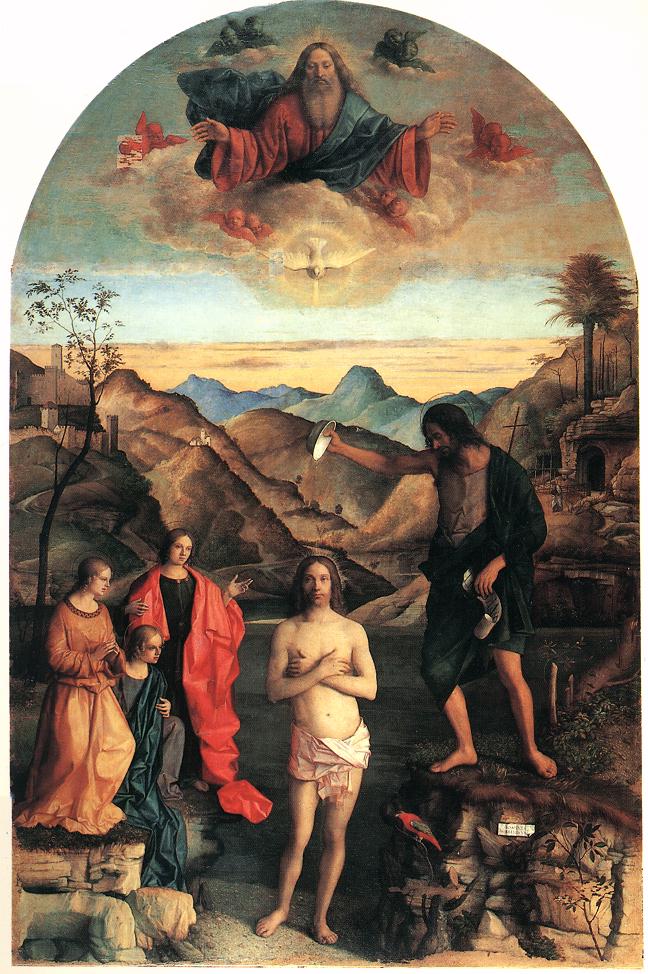
This very large and beautiful painting, with it subtle use of light and colour, can still be found in situ in the side aisle of the once Dominican Church of Santa Corona in Vicenza. Christ is shown centre foreground. He is stripped for baptism, exposing his pale flesh. Light from the right falls on his skin so that this is what draws our eye first of all. Set against the darker tones of the landscape and of the Baptist above him on the riverbank, his skin seems to glow. On the opposite bank, there are three female figures and a tree. It is easy to see an echo of earlier works, such as that of Piero della Francesca’s Baptism now in London. One significant difference, is that Bellini does not even suggest the crowds mentioned in the gospels. His focus is on Christ alone. This same light from the right catches the inside of the bowl used for the baptism. It draws our eyes upwards to the heavens torn open and to the Father clothed in red and blue, surrounded by matching cherubs. As if suddenly let go by its keeper, the dove, who is the Holy Spirit, descends on Jesus. At this the first female figure on the left joins her hands in prayer. The other two each bear the garments of which Christ has divested himself. Looking up you can see that these are the garments of divinity, for they are worn by the Father. In this subtle way, Bellini creates a vertical axis and horizontal axis with Christ at the centre. On the vertical axis the Father, the Son and Holy Spirit are visible. On the horizontal we see the baptism.
Legend said that the waters of the Jordan ceased to flow when Jesus was baptised and so Bellini shows him standing on the dry gravel of the riverbed. Behind him the dark waters of the Jordan are held back. We can pick out the line of the water’s surface just behind his shoulders. This may hint at works by earlier artists like Giotto which showed Christ immersed in the waters. These waters are still, as in the legend, but there is no reflection of the sky or the heavenly scene above. Bellini keeps the two registers distinct, so that the primary focus is on the Incarnate Christ and his pale luminous skin. In the church the natural light falls from the right as it does in the painting. However, the landscape in the background is lit by a different light coming from the left. This means that, for example, we can see the Baptist’s cross as two thin lines set against the brightly lit slopes on the right. It draws our eye also to a hermitage and a figure who is making his way down to the river. Is it for baptism?

It is generally agreed that Bellini based this work on another painting of the baptism. It is was the work of the much younger Cima Da Conegliano and was painted between 1492 and 94 for the main altar of the Venetian Church of San Giovanni in Bragora (see above). However, Bellini altered Cima’s composition significantly. The tree is now further to the left so that the landscape behind Christ is empty. Nothing distracts us from his figure of Christ. Unlike Cima, Bellini actually shows God the Father so that the Father, Son and Holy Spirit are visible along the central vertical axis. Cima had Christ turn towards the Baptist, but Bellini has him face directly towards the viewer. The dominance of this vertical axis is not to be weakened. As we follow these vertical and horizontal lines, Bellini is drawing us into contemplation of Christ who both human and divine.
In 1259 the Bishop of Vicenza had been given a precious relic of a thorn taken from the crown of thorns and had entrusted it to the Dominican friars of Vicenza. They named their convent and church after the relic – Santa Corona. From around 1480, alterations had been made to the church interior to create a shrine for the relic under the high altar. In particular, the choir was moved from the central nave. As a result this altar could be located at that point along the side aisle previously hidden from view by the adjacent choir in the nave Shortly afterwards, the commission for this painting came from a man named Battista Graziani, who had made a vow to erect an altar dedicated to his patron, St John the Baptist, in order that he might return safely from a pilgrimage to the Holy Land. It is very likely that Bellini had in mind these pilgrims who would pass the painting as they came to venerate the relic. This explains why although In Cima’s painting Christ’s hands are joined, in Bellini’s version they are folded across his chest. The hands folded on his chest are a clear reference to Christ as the man of sorrows. Pilgrims who came to venerate the holy thorn would pause before this painting to contemplate Christ’s pure unblemished flesh, which was wounded for their sake. And if as you stand in the nave, and let your eye move downwards from the Father’s red garment to the Son, and then across from his red garment on the left, you will have traced with your eyes, and maybe your hand, the sign of the cross
The Catholic Chaplaincy serves the students and staff of the University of Edinburgh, Edinburgh Napier University and Queen Margaret University.
The Catholic Chaplaincy is also a parish of the Archdiocese of St Andrews and Edinburgh (the Parish of St Albert the Great) and all Catholic students and staff are automatically members of this parish.